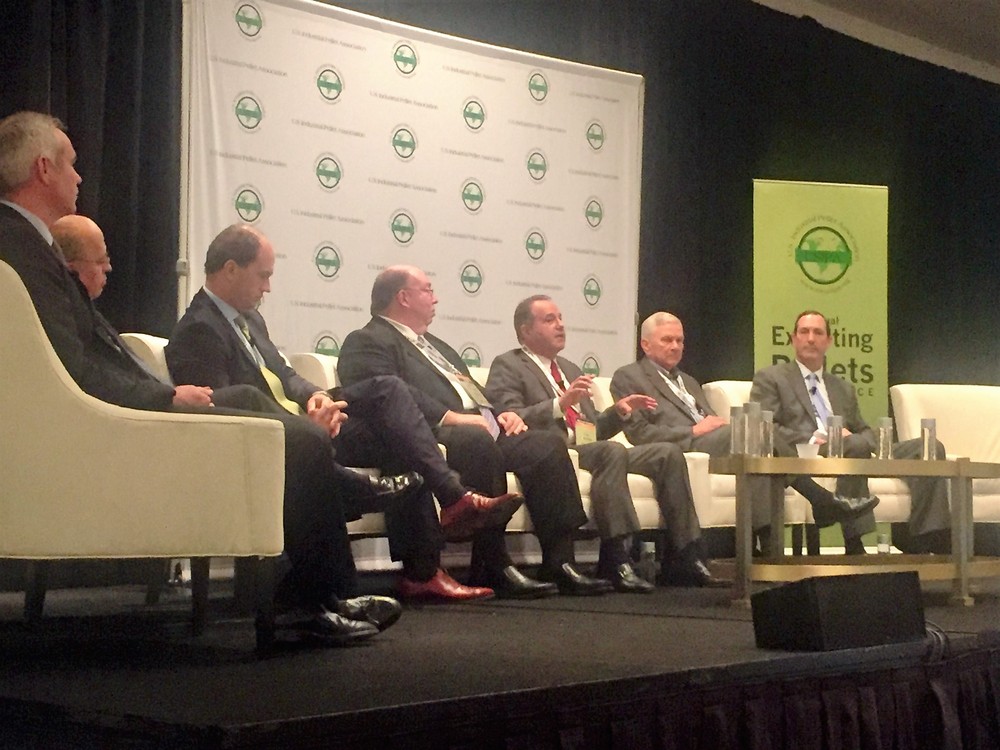US producers provide state of industry update at USIPA 2016







Photo: Katie Fletcher
November 8, 2016
BY Katie Fletcher
The U.S. Industrial Pellet Association's 2016 conference in Miami hosted a larger panel of U.S. producers to discuss the state of the industry, which USIPA executive director, Seth Ginther, attributed to the emphasis on pellet production growth at this year’s conference.
“A lot of this year’s conference has been about growth, and that the industry is growing positively from an incremental standpoint, and I think that’s represented by the increased number of producers on stage this year,” Ginther said. He added that Japan was a target market discussed, and U.S. producers shared there take on it.
U.S. producers represented on the panel held Nov. 8 included Drax Biomass, Highland Pellets, Fram Renewable Fuels, Georgia Biomass, Enviva, the Westervelt Company, and the Navigator Company (previously known as Portucel).
Drax Biomass president and chief executive Pete Madden discussed navigating risk and pursuing growth in the wood pellet industry. He emphasized Drax’s strategy of locating mills in areas where other wood product producers, like pulp and paper mills, had closed down. “We’re bringing capital investment into an area that’s just starving for capital,” he said.
One point he emphasized was the importance of improving cost structure through rail volume. The company’s Louisiana pellet mill and port facility are designed around a unique rail model (80 car unit trains versus 25 to 40 car trains). “Making pellets is easy, but you have to make sure you’re delivering a high-quality product,” he said. Madden added that with some of the prices being thrown around in the spot market, there is certainly tightness, but he’s optimistic it will turn around. Drax hopes to increase its near 1 million tons of capacity to not only their power company, but opportunities all over the world. Madden said, “maybe Japan and other Asian countries, so we’re looking forward to these markets as they open up over time.”
Producers shared some brief updates and projects they’re working on.
Madden shared that Drax is producing at 85 to 95 percent capacity in the U.S., and James Roecker said Georgia Biomass is close to reaching nameplate 750,000-metric-ton-per-year capacity. “We’re investing a couple million over this year and next year implementing projects that help us diversify and optimize our fiber supply,” he added.
Advertisement
Advertisement
Westervelt is expanding a sawmill to generate additional residuals to be used at its pellet plant in the 280,000 metric ton range.
Thomas Meth with Enviva spoke about the company’s approach to replicate its facilities, and that the Sampson plant is a “neat piece of revolution.”
The Navigator Company’s 500,000-metric-ton plant in Greenwood, South Carolina, started up last month.
Tom Reilley with Highland Pellets in Pine Bluff, Arkansas, revealed a few lines coming on in the next few weeks. Like Madden, he mentioned the capital and opportunity pellet mills can bring to the surrounding community. “The story of pellets is a good story, but the story of people is far better,” Reilley said. “We can breathe life back into communities.”
Ginther had each producer on the panel share their take on the Japanese market.
Meth with Enviva expressed that he thinks the market holds real opportunity. He said, although it will take time, the scalability of the market, the value of fiber and the ability to ship cost-effectively to Japan should make the case for U.S. pellets.
Reilley with Highland stated his belief that caution should be taken and they’ll need to have patience. “No one company can satisfy all of the demand that’s coming from any of these markets,” he said.
Advertisement
Advertisement
Mike Williams with Westervelt noted that in regards to Japan, they understand the relationship needed, but they’re at the same stage as a football team a little before training camp.
Harold Arnold with Fram made the point that the Japanese market has potential of being great for the wood pellet industry as a whole, even if it doesn’t benefit U.S. producers, it will benefit some pellet producers. “A rising tide raises all ships,” he said.
Roecker of Georgia Biomass said that you “can’t help but be enthusiastic about the opportunity, but it’s important to exercise patience through this process.” He added, “many of us are operating plants today that haven’t reached capacity so let’s make sure we take advantage of that before breaking ground on new plants.”
Besides Japan, safety was another big discussion point of the U.S. producer panel. Madden said, “If we focus on safety, then reliability improves and production is going to improve.”
Looking to the next 12 months, producers have reason for optimism. “I think our industry having built that supply chain and being poised for future growth, will continue to mature and operate at a realistic price point,” Reilley said.
Madden went as far as to state he’s more optimistic now than ever before. He said, “From the supply chain perspective, logistics, we can do that. Sustainability, we check that box. The new markets are going to open up. There is more discipline in this emerging industry with safety and how we manage our work force driving cost out.”
USIPA chairman Arnold shared that he thinks the reason for optimism will continue to grow through the year, and one year from now, “we’ll be even more opportunistic about the markets materializing in Japan, Europe.”
Upcoming Events





